The Ratcatcher of Hamelin by Julius Wolff
Julius Wolff (1834-1910) was born to a cloth maker in Quedlinburg. He studied economics and philosophy in Berlin preparing to take over his father's business. The company suffered substantial financial troubles and Julius sold it to establish a short-lived newspaper in his hometown. After only one year he joined the army in Germany's war against France as an officer. In 1972 he started a career as a freelance writer. One of his favorite themes was the Pied Piper of Hamelin, done in two separate books, one written as an adventure, the other as a collection of songs. This brought him another award - in 1884 he became an honorary citizen of Hamelin.
You can find a few tidbits about Hamelin, a lovely German city with a few really original ideas for tourists, here:
https://topbeautifulplaces.wordpress.com/2018/01/02/hamelin-germany/
Julius Wolff became a professor in 1904 and in 1910 his home-town Quedlinburg awarded him with honorary citizenship as well. There was also a fountain built in his memory. Julius Wolff's most popular works were Till Eulenspiegel, The Flying Dutchman, The Raubgraf, and already mentioned Pied Piper of Hamelin, here presented with illustrations by Philipp Grot Johann.




































Philipp Grot Johann (1841-1892) also known as Philip Grotjohann, as he often signed himself) was born in Stettin (today's Szczecin) and started his career in engineering, working in the ship- and locomotive-building industry, got his first degree at Polytechnic in Hannover before he met Peter von Cornelius and decided to study art in Dusseldorf, where he remained until his death (with the only longer exception of one year of studies in Antwerp). He soon gained a reputation as a highly competent illustrator, made graphics for eminent authors like German literary giants Johann Wolfgang von Goethe and Friedrich Schiller, and British writers like Walter Scott or William Shakespeare, but worked on other projects, like stained glasses and murals as well. P. Grott Johann's illustrations of Grimm's Fairy Tales are considered as his top achievement. He was chosen to illustrate the first fully illustrated edition for which publishers waited to come out of copyright. There are 180 illustrations altogether! Unfortunately, Grot Johann died before the project was finished, so it was continued by another eminent illustrator of the time: Robert Leinweber, but this is another story.
The Pied Piper (Ratcatcher) from Hamelin presented here was first published in 1876 by Grot'sche Verlagsbuchhandlung in Berlin, the main publisher of both authors presented in this post. Extensive text is written in verse on more than two hundred pages with 18 illustrations (one for each chapter) and 17 vignettes (one chapter ended exactly at the end of the page, so the vignette was not needed. We present all graphics (a cover page from the 1884 edition included) together with the titles for each chapter and a decorative capital letter by which each first verse in the chapter starts. Enjoy the beauty made by classic masters.
The fables of Aesop and others, translated into human nature
Classic Fables illustrated by Charles H. Bennett
A selection of legendary tales written by Aesop, published in 1875 by Chatto & Windus. We are dealing with 22 fables altogether, each with a moral and one illustration signed by Charles H. Bennett (1829-1867). Illustrations were drawn directly on wood and engraved by legendary engraver Joseph Swain (1820-1909). As you can see, all pictures were colored by unsigned artists, which makes this old picture book especially attractive.

Let's enjoy one fable at a time:
The wolf and the lamb

The moral: A tyrant can always find an excuse for his tyranny.
The frog and the ox

The moral: Not all creatures can become as great as they think.
The ass in a lion's skin

The moral: No disguise will hide one's true character.
The lobster and his mother

The moral: You can distinguish from others easily, just have to be boiled first.
The wolves and the sick ass

The moral: The kindness of a legacy-hunter is apt to be killing.
The ape and her two young ones

The moral: A plant may thrive better by the roadside than in a hot-house here a Fool is a gardener.
The daw in borrowed plumes

The moral: Borrowed feathers do not make fine birds.
The lion and the gnat

The moral: The least of our enemies is often the most to be feared.
The fox and the crow

The moral: Do not trust flatterers.
The fox that was docked

The moral: Do not listen to the advice of him who seeks to lower you to his own level.
The dog and the shadow

The moral: It is not wise to be too greedy.
The fox and the grapes

The moral: It's easy to despise what you cannot have.
The mole and her son

The moral: Do not boast of things you do not have.
The cat's paw

The moral: The flatterer seeks some benefit at your expense.
The treacherous cur

The moral: Trust is hard-gained and easily lost.
The dog and the wolf

The moral: Better starve free than be a fat slave.
The dog in the manger

The moral: People often begrudge others what they cannot enjoy themselves.
The hare and the tortoise

The moral: Slow and steady wins the race.
The fox and the crocodile

The moral: Liars are caught out by their deeds.
The ant and the grasshopper

The moral: If you want to succeed tomorrow, you have to start working today.
The wolf in sheep's clothing

The moral: The evil doer often comes to harm through his own deceit.
The wolf and the crane

The moral: Expect no reward for serving the wicked.
This was a selection of 22 fables mostly attributed to Aesop. If you wish to read more fables, there are hundreds and hundreds of them available online. To learn more about the importance of reading fables, visit this page:
Why should you make your personal list of fables? | Many Interesting Facts
Bye for now!
Paul Hey and His Postcards with Scenes from Fairy Tales by Brothers Grimm
Postcards by Paul Hey - Grimm Fairy Tales
Paul Hey was a prolific painter and designer who created hundreds of postcards. Scenes from fairy tales, especially by the Brothers Grimm, were among the most numerous and are still valuable among collectors.
Here is a collection of several dozen postcards with motifs from classic fairy tales with short explanations. They are sorted as the tales were sorted in the first edition of Children and Household tales (Kinder und Housemarchen) as Jakob and Wilhelm titled their famous book.
To avoid confusion their tales are marked by the abbreviation of the book's title (KHM) and serial number:
KHM 1 - The Frog King

This is the first scene from the first fairy tale in the book. Princess has a problem. Her golden ball has fallen in the veil. Will the frog help her out?

This scene presents the major conflict in the fairy tale about the Frog King. Princess gave a promise to the frog but didn't want to keep it. The frog was persistent and the king supported the frog, not his daughter!
KHM 3 - Mary's Child

Religious motifs were present pretty often in the first edition of Children and Household Tales. Mary's Child is one example. Such stories are not classified as fairy tales anymore and are mostly known only to literary historians and die-hard fans.
KHM 11 - Brother and Sister

The story is about a brother and a sister on the run. While she warned him not to drink from the enchanted brook, he couldn't resist and turned into a deer. This a lovely example of the consequences if you give in to temptation.
KHM 13 - Three Little Men in the Wood

Three Little Men in the Wood is one of the numerous fairy tales about two step-sisters. One is nice and rewarded for her behavior, and the other is not nice and consequently punished.
Step-mother, of course, played an important role.

Paul Hey made two illustrations for postcards with scenes from this story.
KHM 15 - Hansel and Gretel

Hansel and Gretel is the most famous fairy tale about a brother and a sister. It bears some similarities with The Little Brother and Little Sister above.
- children are lost in the wood,
- a witch is their enemy,
- the sister helps her brother to survive.

In the end, the cunning of little children prevails over the rough power of the witch.
KHM 19 - The Fisherman and His Wife

A fish is caught and willing to fulfill the wish of the fisherman. He gladly accepts but his wife is not satisfied ...
KHM 20 - Brave Little Tailor

Brave Little Tailor is yet one more tail about a man who improves his social status thanks to help his cleverness. The scene above shows two giants who should be defeated as one of the tasks he faces. The tailor is not able to fight them directly but more than willing to trick them into the fight of one against the other.
KHM 21 - Cinderella

Cinderella is probably the most popular fairy tale of all time. Paul Hey, just like countless other artists couldn't resist portraying her in the kitchen with the birds who are Cinderella's friends and magical helpers.

Yes, Paul Hey used the same scene twice!
KHM 24 - Mother Holle

Mother Holle is a character from Central Europe folklore. She is responsible for the changes of seasons of the year. When a girl comes to her place, she has to make up her bed. By shaking her bedding she causes snow.
KHM 26 - Little Red Cap

The scene above is one of the most known ones in the literature. Little Red Cap meets the wolf ... As you can see, this is the version with a bottle of wine in the girl's basket which is interpreted in many different ways. Especially if we know it's a bottle of red wine.
KHM 27 - Town Musicians of Bremen

Bremen Town Musicians are not from Bremen. They are just heading to this German city and never got there. Instead of that, they invade a hut, occupied by robbers, and established a nice home for all the animals in 'the band'.
KHM 33* - Puss in Boots

Puss in Boots is trying to convince the peasants to inform everybody that the land is owned by his master, not by an ogre who is the real owner. Puss is a typical trickster, just like many similar characters in folk tales and the message of Puss in Boots is somehow iffy. It's also important to note, that Jakob and Wilhelm Grimm included this story in their first edition only. When they realized it was not part of the German cultural heritage, they skipped it in later editions.
KHM 36 - The Magic Table, the Golden Donkey, and the Club in the Sack

Here we are again, with a classic plot: three brothers, three magic objects, an enemy (presented through three characters), and a happy end. This formula can be seen in countless fairy tales and is also used in other forms of literature (fiction and non-fiction), too. Number three is extremely useful and powerful in countless areas of communication.
KHM 39 - Elves and Shoemaker

Very interesting story about little helpers who secretly make shoes for a poor shoemaker and help him to become rich. When he and his wife decide to reward the elves, they stop working and leave the house! The moral? Don't be generous to your workers ...
KHM 50 - Briar Rose

Briar Rose, today more known as The Sleeping Beauty is another classic in children's literature. We can trace its origins at least to the 13th century and found several pretty saucy versions. The scene with the prince who finds the sleeping princess in the castle is present from the very beginning and Paul Hey is just one of thousands and thousands of artists, who tried to catch the magical feeling.
KHM 53 - Snow White

Snow White is another popular classic. It definitely owns a huge part of its popularity to seven dwarfs who are in this case very nice and forthcoming, although a bit incompetent. Again, we are dealing with the magical number three, a resurrection, and fierce competition between two women.
KHM 82 - Hans in Luck

Hans who finds luck in everything that happens to him is a typical story about a simpleton who constantly makes wrong decisions. This funny story can't be really presented as a fairy tale, but is definitely still popular among the kids, and, to be honest, not without a very special moral value.
KHM 89 - The Goose Girl

The Goose Girl is a classic fairy tale about growing up. Through treason, false identity, and a dilemma about keeping her promise (although enforced), she slowly but surely transforms from a naive girl to a marriage-worthy princess. Her golden hair is her signature sign and painters loved the scene of combing most of all.
KHM 119 - The Seven Swabians

Seven Swabians travel the world and their adventures are so funny, they are written and rewritten over at least five hundred years. Again, this is not a fairy tale by definition but worth reading anyway. Did you know in Germany people from Swabia (South part of the country) are called Swabians, but in Switzerland, all Germans are called Swabians?
KHM 153 - Star Money

The Star Money is a short story with a very strong message - all good deeds will be rewarded. The bigger the sacrifice, the higher will be the reward. The girl in this tale goes so far that she gives even her shirt to help poor people, which results in silver money dropping down the sky and making her rich in the end. So moralistic stories are not favored by the audience anymore for many years so The Star Money is almost forgotten today.
KHM 161 - The Snow-White and Rose-Red

The scene above presents the idyllic life of sisters named Snow-White and Rose-Red. They are nice and have many friends, including a talking bear, who is (what else) an enchanted prince. All three together have to deal with a wicked dwarf but their task is finished smoothly and without a real conflict this fairy tale slowly wanes out of fashion too.
KHM 187 Hare nad Hedgehog

Again, we are dealing with a story which can't be called a fairy tale. The Hare and the Hedgehog is a classic fale where wit defeats strength (or, to be more specific, speed). Brothers Grimm included all kinds of stories which they found suitable for their purpose, in their collection and the fable about the competition between hare and hedgehog can be easier found in collections of fables nowadays.
All presented images are in Public Domain. If you like them, share this article with others.
Anne Anderson's Old, Old Fairy Tales
Old, Old Fairy Tales by Anne Anderson
This picture book (just 20 pages with rigorously shortened stories) is a collection of shortened classic fairy tales, dominated by stories from the collection of the Brothers Grimm. It was published by Whitman Publishing Company, Racine, Wisconsin, USA in 1935.
It's not clear when the illustrations were made but here signature touch with an influence of Art Nouveau is obvious. Strong colors, many details, and decorative borders are clear examples of her work.

The front cover of the book features the scene from Goldilocks (often titled The Goldilocks and Three Bears) where the family of bears returns home and finds the intruder in one of their beds.

The Swan Princess is more known as The Six Swans, a fairy tale by Jacob and William Grimm. It tells a story about a girl who has to go through great dangers to rescue her brothers, who turned into swans.

Briar Rose, widely known as The Sleeping Beauty, is another classic from the Grimm collection. The story of a girl who is punished for her father's mistake with a hundred years of sleep until a Prince Charming rescues her is still among the most lovable.

Beauty and the Beast is not only one of the tales which don't belong to the collection by the Brothers Grimm, but it's also a story with a known author (Jeanne-Marie Leprince de Beaumont), although it's actually an echo of an old myth (or several myths).
It's always interesting to compare how different illustrators present the Beast. In this case, Mrs. Anderson decided to give him the look of some kind of giant reptile with a lot of tiny details, as expected of her style.

The Three Dwarfs (in the Wood) or The Three Little Men belong to Grimms. We have a classic situation with a daughter and stepdaughter, an incompetent father, and a wicked stepmother. The daughter is given an impossible task but finds her way to return home as a rich girl and her stepmother got an idea to make her own daughter rich too.
Of course, we all know how such plans pan out. A classic moral with many similarities to other fairy tales, like Diamonds and toads by Charles Perrault, for instance.

Frog Prince is today better known as Frog King and the scene at the fountain or the pond is by far the most popular one among illustrators. It's packed with symbols, from the golden ball to the frog and the relationship between the frog and the princess which changes through the tale.
Anne Anderson used an opportunity to add many tiny details as we should expect from Art Nouveau.

Again, well-known fairy tale, probably the most popular one in the world. Origins of Cinderella or Little Glass Slipper can be traced at least two thousand years back in history and it seems we'll never get bored of the story about a girl who lost everything but her spirit.
Charles Perrault ended the story as an opportunity to forgive but Jacob and especially William Grimm saw it as a chance for bloody revenge. Today Perrault's version is way more popular but we can never be sure that that can't change soon.

Rapunzel is another classic story about a damsel in distress, sharing its elements with Briar Rose and Rumpelstiltskin (incompetent father, captivity, magical enemy, ...). Heroine's long hair is one of the most well-known characteristics of all fairy tale characters in the world.
Hair was considered a bearer of magical powers (just think about Sampson) in many cultures and, if we think a bit, still is with millions of ladies spending a fortune for their hairstyle and men trying to avoid baldness.

Rumpelstiltskin is another variation of another old superstition - little people, living in the wood, praying for children, and luring them into the fairy world. It starts whit a miller claiming that his daughter can spin straw into gold, putting his only child in deadly danger.
The girl got an unexpected helper but this comes with a price. she has to give her only child to the little man who can do exactly what was expected from her - spin straw into gold. They stroke a bargain. She can keep the child if she guesses his name. The picture above shows the man dancing around the fire and singing about his strange name expecting he'll get the kid.
Rumpelstiltskin (just like Briar Rose and Rapunzel) was also illustrated by Anne Anderson in Fairy Tales of the Brothers Grimm, in this case, titled The Millers Daughter (the Scottish version of the same story with the same plot).

Mother Holle aka Mother Hulda, another fairy tale by the Brothers Grimm is a story with a very similar plot and message as the tale Three Dwarfs in the Wood: good deeds are rewarded and bad behavior punished. There are also two daughters and a wicked stepmother. The ending is almost the same.
Brothers Grimm firmly believed that fairy tales should teach about the proper behavior of children as they are growing up and learning about life as it should be, not as it was.

This fairy tale comes from Perrault's Mother Goose and tells a story about poor kids who were led by the youngest who got involved in a conflict with a giant. They escaped and stole his seven-mile boots, acquiring a magical object which enabled the family to earn enough money to escape their poverty.
While we mentioned Perrault for the third time it's probably right to invite you to check how Harry Clarke portrayed some of the very same (or their variations) stories in Perrault's Fairy Tales.

This illustration of Hansel and Gretel meeting the man-eating witch comes from the back cover of the picture book presented above. We all know what happens next, but this should not stop us to review the whole story, first changed into opera by Engelbert Humperdinck with libretto by Adelheid Wette, just another vision of one of the immortal classics in Hansel and Gretel, illustrated by Maria Louise Kirk.
In this article, you can further explore Anne Anderson's illustrations.
If you enjoyed the article, share it with your friends. Cheers!
Bluebeard's Wives
The Six Wives of Bluebeard
Can you name all Bluebeard's wives? Do you know at least who was his last one?
Sometimes you need a name for a crossword, sometimes you just want to check how the seventh wife (some even search for the eights) was called, and sometimes you need a full list of Bluebeard's dead wives. Here is a book which might help you with that.

Or maybe not. By many the best story about the wives of notorious serial killer called Bluebeard is written by Anatole France. According to this, his wives were:
- Colette Passage
- Jeanne de La Cloche
- Gigonne Traignel
- Blanche de Gibeaumex
- Angele de La Garandine
- Alix de Pontalcin
- Jeanne de Lespoisse
Anatole France's story presents his wives in a bit different light than people only familiar with a fairy tale may be aware of.
In the fairy tale, they are indisputable victims but when we are informed by their previous positions in their lives and relationships with Bluebeard, things definitely look different.
There are also several stories with six or eight wives of Bluebeard altogether.

For this occasion, we'll focus on the less known book by Sabilla Novello. It's titled Six Wives of Blue Beard from Mendacious Chronicles. It is written by Sabilla Novello and dedicated to her nieces Porzia and Valeria dei Conti Gigliucci.
Not much is known about Sabilla Novello and the situation with illustrator is very similar. He is signed as George Cruikshank Junior what gives us an impression he is a son of a very successful George Cruikshank who was still alive in the time of the publishing of this title. Thanks to the fact George really signed himself as Jr. on several occasions there's also an opportunity he authored the illustrations. Maybe he just helped at designing the cover, adding his monogram in the left down corner.

But looking at the pictures, their style, and especially the vivid colors, the author is most likely George Cruikshank's nephew (son of his brother Robert) whose name was Percy George Cruikshank. Using the name of his famous uncle and even his monogram on the cover can be just a marketing trick for better selling of the book. This puts us in an ungrateful position of not knowing the exact copyright status of the book. Percy George Cruikshank's date of death is unknown.
We can rely only on the fact he was not active after 1884. We also know he was born in 1842 what means he should live way over one hundred years (to die after 1949) to keep the copyright of presented pictures out of Public Domain what is very unlikely. So we'll present them anyway. Each picture carries a story and they are presented as well.

Bluebeard while his beard was not blue yet
Pompernicus Gynicide was a nobleman. He was brave and elegant and almost ready to be married. Apart from having a temper and occasionally impulsively killed a few servants, he looked like a very good catch.
His godfather Estrellus who was skilled in black magic suggested to Pompernicus' mother making a horoscope to find a perfect match. Soon he realized there's something strange with the fate of the young man. No matter how he calculated, there was a warning - Pompernicus will be in very great danger because of the curiosity of his wife.
Estrellus believed and Lady Gynicide agreed. The only option to prevent the tragic consequences of the marriage would be marrying Pompernicus with Estrellus' daughter Basbluella.
Basbluella

BASBLUELLA: "I throw the Blue 1n thy Beard!"
Young Baron Gynicide and Basbluella married yet soon realized their characters don't truly match. She was all about books and he was all about tournaments and combats. Once when he insisted she should join his company at hunting she was just practicing black magic and more or less incidentally changed the color of his splendid beard into blue.
Blue beard became an object of ridicule among his friends and later Pompernicus angrily cut her throat. He told Basbluella's father she died in an accident practicing her dark skills and he believed. Her body was embalmed and put in one of the chambers in the tower. Pompernicus became very depressed and soon stayed almost without friends.
Rose

He sought out ROSE, and asked her if she would like to be married
As a widower Pompernicus more and more evaded company. He referred wandering around the forests and mountains. One day he met a shepherd and they liked each other. Shepherd introduced him to his granddaughter Rose who saw only a couple of old men and wasn't shocked by the strange color of Pompernicus's beard. She even told him they had a habit of naming people after particular characteristics. Just like she was called Merry-voice, he should become Bluebeard.
Soon he realized the naive girl could be a good wife, especially after his too educated first wife. After a few minor comical complications, she married him and became a lady of the house. There each of her whims was readily served with one exception. she was forbidden to enter the tower where Bluebeard and his ex-father-in-law practiced rituals in an attempt to restore the color of his beard to normal.
But she could not resist. One day, when her grandfather visited the castle and she felt particularly self-confident, she led him right to the tower. Believing her husband won't punish her she entered the forbidden room when Bluebeard and Estrellus were in and her husband cut off her head. When her grandfather started cursing him, he stabbed him in the heart.
Now two dead wives lied in the chamber. Bluebeard started heavily drinking and gambling, with numerous bursts of his temper. After a while, his godfather realized he'll die soon and told him he should still beware of his wife's curiosity. He had two options - to not marry or to test his next wife's curiosity. For this test, he gave him a key to the forbidden chamber with his wives' remains. The key was transformed with magic - if anybody but Bluebeard opens it, it will change its color.
He also tried to add he should, by all means, avoid a woman named Fati... but died before he told the name.
Princes Violante

He struck off the Head so dear to VIOLANTE
After the death of his second wife and his godfather, Bluebeard focused on hunting for some time. Then he heard about a tournament with an interesting price: the winner will get a princess Violante for his wife. Bluebeard started well, winning the first day and remained hidden under his helmet. At the end of the day, he even refused to take the trophy saying he came to win all. That charmed the king but not the princess who was obviously interested in a handsome knight named Gaetano.
When Bluebeard won the second day, he was very tired and a bit wounded. When he was resting a damsel visited him with a warning. Her name was Gelosinda and she heard her princess plotting with Gaetano and a doctor about poisoning Pompernicus Gynicide. He thanked her and in the morning tricked the doctor who believed he drank the potion while he threw it away. Then he won the last day of the tournament. For the grand finale, he decapitated Sir Gaetano.
The wedding party was a disaster with the bride crying in her rooms, without any dancers, and king and Bluebeard being only ones eating. After a few days, Bluebeard took his third wife with some of her damsels (Gelosinda included) to his castle. There he warned her not to enter the tower with dead bodies of his first two wives. He also balsamed the head of Gaetano and continued spending a lot of time hunting.
Step by step Galesinda convinced princess Violante she should enter the tower at least to say farewell to the head of her dead lover. When she did that, she found both death wives but Bluebeard caught her and cut her head with his scimitar as well.
The Lady Gelosinda

GELOSINDA stopped in astonishment
Bluebeard sent a coffin (keeping the body for himself) and a message to Violante's father. He made up a convincing story about princess death and everybody believed. All her damsels with an exception of Gelosinda who pretended illness left the castle. Her plan was simple and effective. She wanted to become the next wife of Pompernicus Gynicide. So she did. But she was very jealous. His constant hunting and secret businesses in the forbidden tower drove her mad. She believed he has a mistress there. His numerous nightmares
One night she followed her husband in the tower where she discovered the dark secret - dead bodies of previous wives. She begged for mercy but Bluebeard stayed true to his promise. He cut her throat and balsamed her remains.
Princess Timidella

TIMIDELLA: The Princess rushed into Bluebeard's arms
Pompernicus Gynicide aka Bluebeard remained single for some time, spending his days mostly hunting and looking for adventures. One day a dwarf met him and told him about a giant who kidnapped a princess Timidella. He locked her in a tower waiting to gain some fat so he could eat her.
Bluebeard challenged the giant. Timidella's striking beauty distracted him so much the giant managed to wound him. However, with some help from the dwarf and Timidella, Bluebeard cut the giant's head off. He went to Timidella's father where a great party took place. Timidella who had a very panicky character started showing romantic interest yet her father didn't like Bluebeard who looked too strange, so he decided to leave.
But Timidella followed him by herself and soon they married in his castle. They were happy together and Bluebeard almost forgot his dark secrets. He even got a son. Unfortunately, the son of the killed giant started looking for Bluebeard and his wife. He wanted to catch them both and eat them. This news had two consequences: Bluebeard went out to find the giant and kill him just like he killed his dad, and Timidella started panicking.
Believing the safest place in the castle was the forbidden tower, she entered with the key, given by Bluebeard as a sign of trust and found dead bodies of four wives. The key changed color and she ran out. Being in her room again she killed herself with a knife. Bluebear became a widower again, but this time he had to take care of his son too.
Boy was shy and sensitive like his mother, so Bluebeard decided to find a way to make him stronger and more self-confident. For this reason, he contacted a wise woman from the neighborhood, a widow known by her medical knowledge.
The Widow Huswifina

HUSWIFINA: The Widow readily consented to prescribe for the Baron's sickly Son
Huswifina readily accepted the mission of improving Bluebeard's son. She moved to the castle and started commanding the servants who had to renovate almost every corner. There he got her a laboratory next to his son's room. She started giving him more and more inedible potions. The dwarf, who stayed in the castle after Timidella's death, hated her but Bluebeard was impressed by her efforts and soon he took her for his sixth wife.
Not long after this, son died and Huswifina focused on Bluebeard's health instead. Her other favorite pastime was cleaning the castle. When Bluebear went on a bit longer travel, the dwarf took advantage and, knowing ho dangerous would be for Huswifina entering the tower, started convincing her to clean that place as well. But she kept her word and didn't want to enter the place, forbidden by her husband.
Dwarf, however, decided to enter himself, just checking if his dear Timidella's body ended with other wives. Huswifina noticed the missing key and followed the dwarf. When she approached the door of the forbidden chamber, he pushed her in and locked the door after her. In the night he returned and found Huswifina dead. When Bluebeard returned, he told him that Huswifina couldn't resist her curiosity, entered the tower, where, he, the dwarf and his faithful servant struck her to death.
Bluebeard felt kinda relief. On his trip, he met a poor family with two lovely daughters and several sons who all became soldiers. He decided he should marry the elder of the daughters - Fatima.
This book was published by Grant & Co. in London, 1875
How Fatima became Bluebeard's wife and how her curiosity eventually led to Bluebeard's death, is an already well-known story. To refresh the memory and maybe learn a bit about its strong symbolism and historical background you can check here:
https://hubpages.com/relationships/Bluebeard
If you enjoyed the story about Bluebeard's six wives, share it with your friends!
The Fairy Tales Of Charles Perrault illustrated by Harry Clarke
How Harry Clarke saw Charles Perrault's Fairy Tales?
This is a very special book for at least two reasons. It's a translation of Perrault's Histoires ou Contes du Temps passé (Les Contes de ma Mère l'Oye) or Tales and Stories of the Past with Morals (Tales of Mother Goose).

Although it's practically the last of Perrault's projects, written when he was almost 70 years old, signed by his son's name and written as a sort of parody, it's by far his most important work. He wrote eight fairy tales among which we can see some of the most popular ones ever: Red Riding Hood, Cinderella, The Sleeping Beauty and Puss in Boots. He set the tone of the modern fairy tale as a genre, gave red color to the Riding Hood and described the slippers of Cinderella (here titled as Cinderilla) as made of glass. He added a moral (or sometimes even two of them) to the end of every story, emphasizing the educational potential of fairy tales (even if this was probably not his intention) which were made for grown-ups only in his time.


Thanks to this book the fairy tale as a self-standing-genre was born and Charles Perrault is rightfully proclaimed as the father of fairy tales. While none of the plots in this book is original and all stories were printed before his birth, Perrault showed the way to hundreds of writers who started writing, collecting, editing, and publishing fairy tales in next centuries. Yes, they started and never finished. Fairy tales are still being written after almost the same pattern as he used at the end of the 17th century.

The other reason why is this book so special are illustrations by Harry Clarke. His approach to already classic work of world literature is brave and unexpected, probably not aiming at kids as default audience at all. Thanks to his skills we can enjoy in dramatic black and white drawings where the tension between characters is obvious.

Each fairy tale is accompanied with a full-page color illustration with strong black linings yet often with colors which are often presented with numerous blending shades. Such an approach gave the illusion of space but not a typical 3 D space (children's illustrations are almost always 2 D). Clarke's color pictures are somehow elusive just like the scene is partly present here, in the real world, partly in some other (fairy-tale?) dimension.


There are also many decorative elements, one of the characteristics of the Art Nouveau movement. These are not always pretty as we expect in majority of cases. They often give a grotesque feel, what reminds as of another genius artist - Aubrey Beardsley (1872-1892). There are in general three or four unique illustrations for each fairy tale with a decorative vignette at the end (at the moral of the story). Sometimes there are two decorations and all of them are repeated for several times.
Let's take some time to look at fairy tales as they are sequenced in the book with scans of all illustrations:
Little Red Riding-Hood

This version of Red Riding Hood is slightly different than the version by Brothers Grimm we are mostly used to. At Perrault there is no hunter. The wolf eats the granny, then the girl and it's over.

(He asked her whither she was going)
The moral is simple: don't trust old guys. They are ultimate predators!
The Fairy

You may know this story under a different name: Diamonds and toads.

It's a classic rivalry between sisters. One is a victim and is rewarded for her kindness. The other is punished for her vanity.

Am I come to serve you with water, pray?
One of the girls gets diamonds, the other loads of toads.

Author offer two morals in this case:
- Money is great, manners are even greater.
- Your behavious will evetully be rewarded.
Blue Beard

It's next to impossible to find this fairy tale about a mass murderer in modern collections. It's just too scary.

(This man had the misfortune to have the blue beard)

(What, is not the key of my closet among the rest?)
She betrayed his trust by looking into a forbidden chamber. So she must die.

There are two morals again:
- Curiosity can kill you.
- There are no husbends like Blue beard was anymore.
The Sleeping Beauty in the Wood

Everybody knows the story about the princess being cursed and waiting for the prince to wake her up after long long time, right? Wrong. This is an older version, specific to Perrault, which is closer to older variations of the fairy tale, like Sun, Moon, and Talia.

(At this very instant the young fairy came out from behinfd the hangings)
Apart from some minor differences like the number of the fairies in Perrault's (presented in this book) and Grimms' (most known) versions, there is a whole new world of plotswhen we find out the prince has a secret - his mother is a meneating ogre and his wife should fight for her life. And the life of their kids!

(The prince enquires of the aged countryman)
In the end, somebody has to die. Which lady will be prince's new favorite?

(He saw, upon a bed, the finest site was ever beheld)

(I will have it so, replied the Queen, and will eat her with a Sauce Robert)
As we can see, Perrault had a great although sometimes very black sense of humor.

How about the moral?
You may have a hundred years for a good husband and yet there will probably be more obstacles to the relationship.
The Master Cat or Puss in Boots

Another well-known story about the miller's sons who didn't inherit equal parts of father's heirloom. The youngest got just a cat.

But the cat was not an ordinary animal. With a pair of boots it transformed into an extremely resourceful helper and made his master a king!

Once more two morals of the story are offered:
- It's great to have a property, but it's even better to know how to act.
- Youth and good clothes may be enough to win a heart of a princess.
Cinderilla; or, The Little Glass Slipper

While there are more than one thousand known variations of Cinderella, this one is still best know in the world. It's the first one with glass slippers and with a happy ending where Cinderella (in this translation called Cinderilla) forgives her wicked sisters.

(Any one but Cinderilla would have dressed their heads away)

(Away she drove, scarce able to contain herself for joy)

(She left behind one of her glass slippers, which the Prince took up most carefully)

We are already accostumed to two morals:
Grace her make you a queen.
No matter what are your qualities and how many of them you have, you still should obey your godmother.

Riquet with the Tuft

This story doesn't belong to the best. It's about an ugly prince who is blessed by a fairy. He is not only extremely witty and likable but can make smart his true love as well.

When he meets a beautiful princess who is also very stupid, his mission is about to be completed.

Guess what? She was 'blessed' by the same fairy too.

Morals:
- We are always attracted to beautiful minds. If they are paired with beautiful bodies even better.
- Love can find the best in everybody.
Little Thumb

Little Thumb is a fairy tale very similar to Hansel and Gretel. Instead of a brother and a sister there are seven brothers lost in the wood. The youngest is the smartest.

(He brought them home by the very same wy they came)
Instead of the witch they find a house with an ogre. He is a maneater too.

(Little Thumb was as good as his word, and returned that same night with the news)
The second half of the story resembles Jack and the Beanstalk.

The moral of the story?
Sometimes the least respected member of the family brings the best.

The Ridiculous Wishes

There was a poor woodcutter, angry for not having a chance to fullfil a single tiniest wish. But he got a chance. He was granted three wishes!

(Jupiter appeared before him wielding his mighty thunderbolts)
He decided to choose his wishes very carefully. Together with his wife.

(A long black pudding came winding and wriggling towards her)
Well, their wishes were not so smart after all.

(Truth to tell, this new ornament did not set off her beauty)

The moral is obvious. If you are stupid, the gifts of the gods won't help you.

Donkey-skin

This fairy tale is out of fashion for long time now. It belongs to the family of stories related to Cinderella. But there's a twist - instead of the prince her own father is in love with her.

(He thought the Princess was his Queen)
When the princess realized his intentions, she ran away.

(Another gown the color of the Moon)
She disguised herself, she made impossible wishes, ... It was not enough.

(Curiosity made him put his eye to the keyhole.)
Fortunately, the king found his queen, the princess got her prince and everybody was happy.

The moral is a bit different than the morals before: although the plot in unbelievable, it can still entartain some audience.

With this we conclude the review of The Fairy Tales of Charles Perrault, illustrated by Harry Clarke. The book was published by George G. Harrap & Co., London in 1922.
Andersen's Fairy Tales and Legends illustrated by Dugald Stewart Walker
Fairy Tales and Legends by Hans Christian Andersen with Dugald Stewart Walker's illustrations
Dugald Stewart Walker (1883-1937) was an insurance salesman at first but soon realized this job doesn't suit him. He found his mission in the world of art, studying drawing at the University of Virginia and New York School of Art. His style differed him from his contemporaries in the USA. Critics rather compared his work with Arthur Rackham and Edmund Dulac. Original and eccentric execution of illustration probably achieved the peak in the collection of fairy tales by Hans Christian Andersen which succeeded great success.

Dugald Walker described himself as a man who never grew up. He never traveled and his audience can't expect him to draw an exact scene from the North Pole or China. But if they are willing to look at giants, magicians, and other mythical creatures through kid's eyes, as the young mind believes something should be, his illustrations are the right medium for that. Another important milestone in his career was a collection of fairy tales Dream Boats: And Other Stories which he wrote and illustrated.
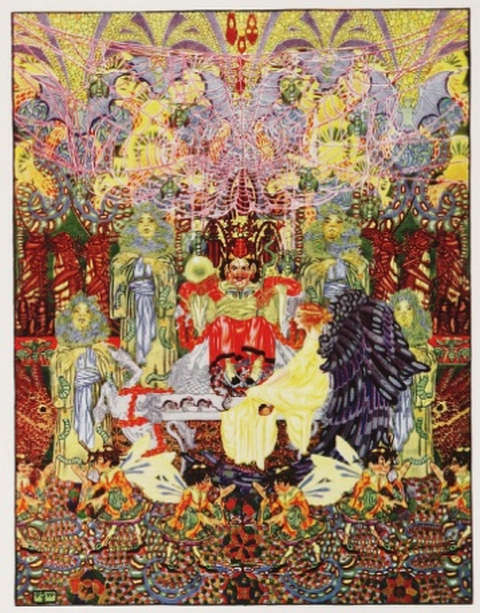
The courtiers looked most grand and proper ... Numbers of tiny little elves danced around the hall
Here is a complete set of Dugald Stewart Walker's illustrations for Andersen's Fairy Tales, published in 1914 by George Sully & Company. The text below some of the illustrations is the same as the text in the original publication.

The Mermaid

The Mermaid (more known as The Little Mermaid) is a tragic story about a little mermaid who fell in love with a prince. She saved his life but he never finds that out because she hid when he regained consciousness. They came to different worlds after all. But she tried to enter his world, sacrificing everything, going through extreme physical and psychical pain, just to be disappointed and betrayed. Her sisters tried to save her but she decided to stay faithful to her mission - being a part of the world with eternal souls.

She held his head above the water and let the waves drive them whitersoever they would
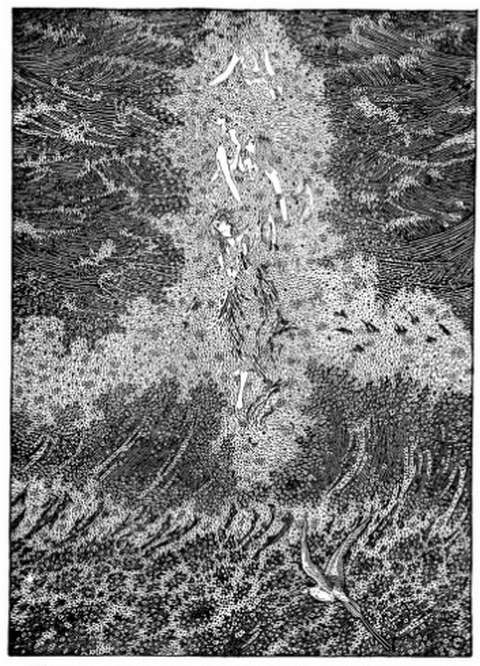
Then she saw her sisters rise from the water, they were as pale as she was

The Flying Trunk

This is a bit funnier story although still without a happy ending. A boy who lacks responsibility loses everything but becomes an owner of a flying trunk. This magical object gives him a chance to meet and charm a real princess, who believes he is an angel. He makes a great impression to her parents too but still lacks responsibility and celebrates the promise of marriage so much he set a trunk on fire. So he stays poor boy but has at least a good story.

And he told her all about the storks, which bring beautiful children up out of the river
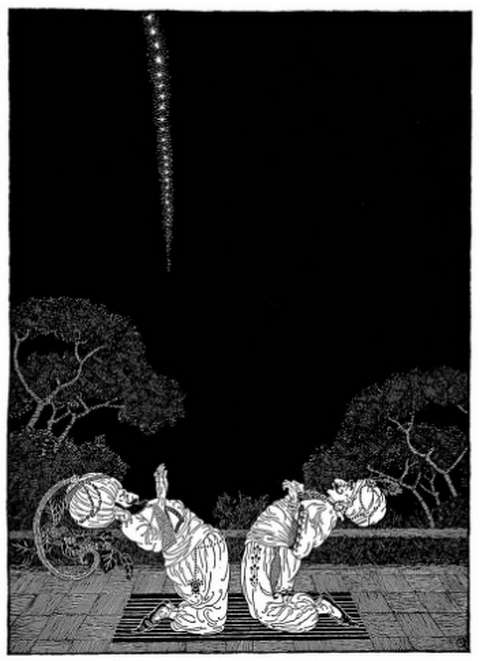
I saw the prophet myself ... his eyes were like shining stars, and his beard like foaming water

The Red Shoes
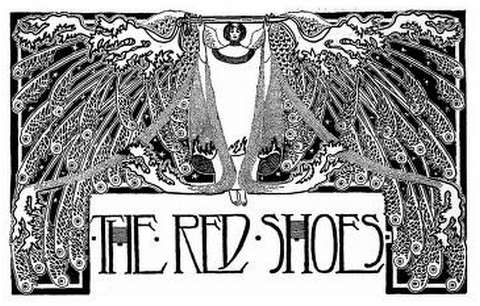
It is a fairy tale about a girl who loved to dance so much she thought only about dancing and enjoying. She got red shoes with magical powers and despite all warnings wears them everywhere. Even on Sunday in church. But the shoes start dominating her, she became unable to stop dancing, she can't take them off and must cut off her legs to stop dancing before dies of exhaustion. She lost legs and newly regained faith is her only compensation.
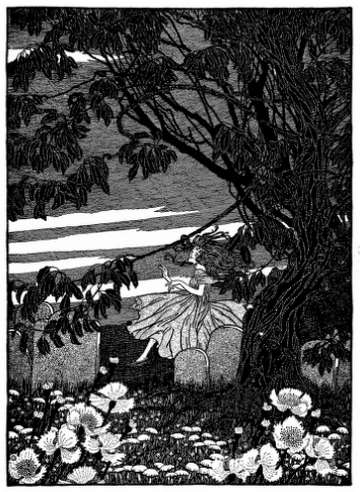
She wanted to sit down on a pauper's grave where the bitter wormwood grew

You can't know who I am? I chop the bad people's heads off, and I see that my axe is quivering

Her soul flew with the sunshine to heaven and no one there asked about the red shoes
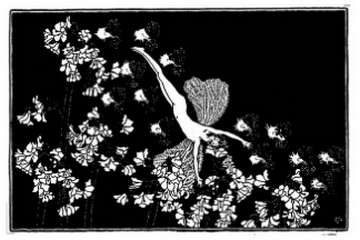
Thumbelisa

Thumbelisa is one of the less used names for Thumbelina, one of the most successful fairy tales by H. C Andersen. Thumbelina is a small girl, not bigger than a thumb, who is thrown in the big world of action, power, and dangers, always being pushed around by others, stronger characters. Despite everything, she becomes a friend with a swallow who carries her in a new world, where she meets a flower prince and finds her place among flower people.

She was so happy now, because the toad could not reach her and she was sailing through such lovely scenes
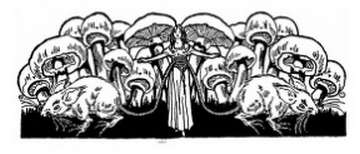
The Girl Who Trod On a Loaf

The Girl Who Trod On a Loaf is almost forgotten fairy tale about a girl called Inger. She was pretty but vain, ashamed of her own mother, and ungrateful for everything good she got from people around. On one occasion she had to go across mud but didn't want to dirty her pretty shoes, so she stepped on a loaf of bread she was carrying to her old parents. The loaf with her sank down to the marsh and she soon ends in Hell. After many years she is pitied by an unknown girl and in the end, she is finally forgiven her pride and arrogance.
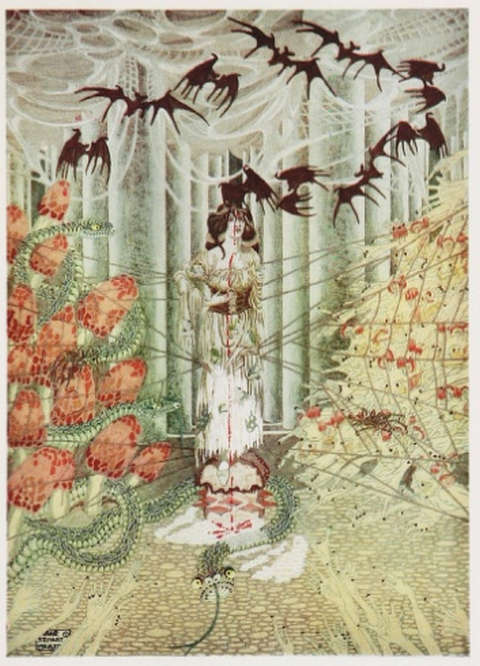
Tears of sorrow shed by a mother for her child will always reach it; but they do not bring healing, they burn and make the torment fifty times worse
The Nightingale

The Nightingale is a lovely fairy tale about friendship among a king and a bird. While this friendship becomes jeopardized thanks to the gift from the Emperor of Chine - a mechanical bird, the nightingale never forgot his king and returns to help him when Death already sits at his bed. Everybody else turned away, the mechanical bird is already broken, but the sincere love from the nightingale wins and his friendship with a king is there to stay.
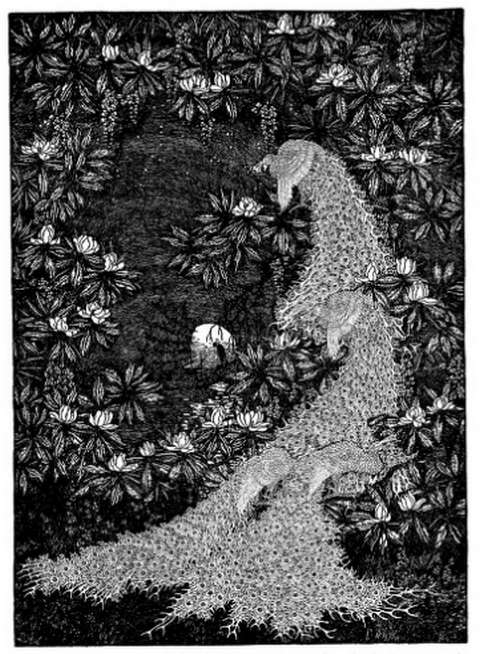
Heavens, how beautiful it is! he said, but then he had to attend to his business and forgot it.
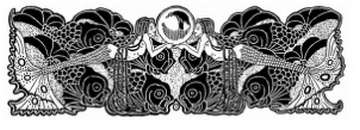
The Garden of Paradise
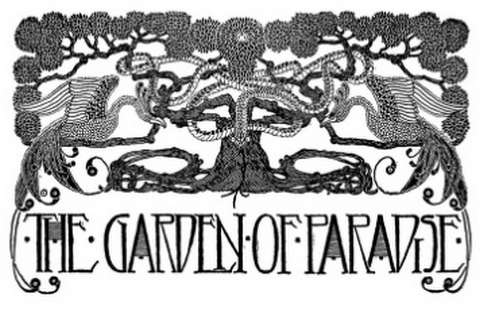
This fairy tale is about the prince who is smart, well-read, and generally happy but still seeks for very special knowledge. He wants to know where is Garden of Paradise and how it's in it. His journey is similar to many journeys from folktales - he is lost in the wood and finds a mother of all four winds. The last one of them really takes him to the Garden of Eden where he must resist temptation. Of course, he doesn't ...
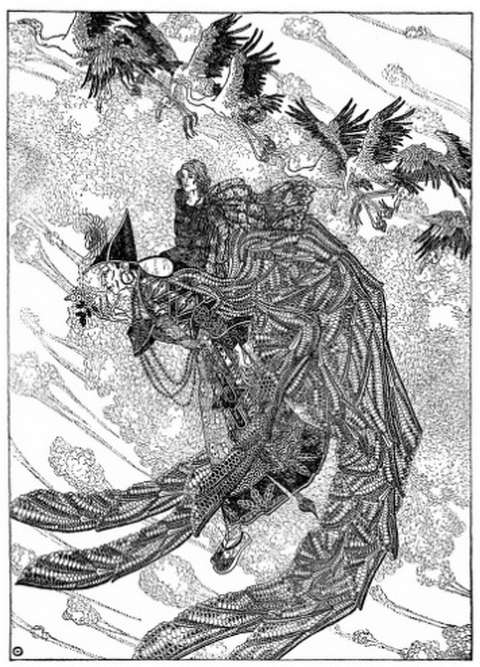
The eagle in the great forest flew swiftly, but the Eastwind flew more swiftly still
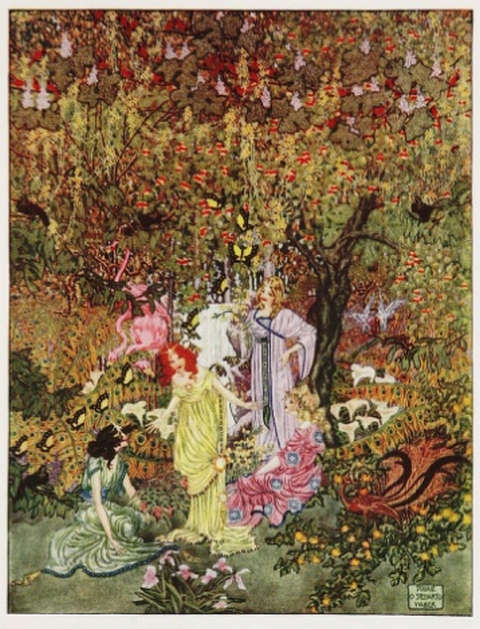
The Fairy of the Garden now advanced to meet them: her garments shone like the sun, and her face breamed like that of a happy mother
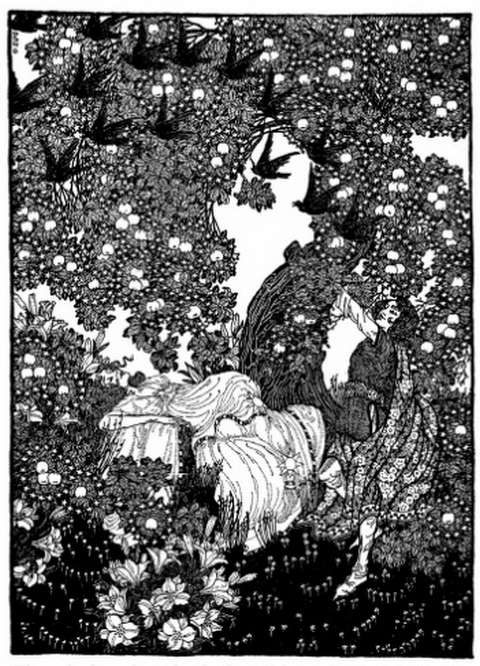
There she lay asleep already, beautiful as only the Fairy in the Garden of Paradise can be
The Wind's Tale
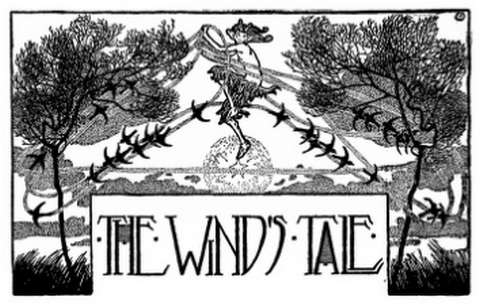
Sometimes subtitled as About Waldemaar Daa and his Daughters it's a pessimistic tale about a nobleman and his three daughters told by the wind. The nobleman was an alchemist who was constantly seeking more money and prestige. A rich and beautiful wife was not enough. Lovely daughters didn't make him happy. He wanted to know how gold is made and he sacrificed whole family fortune for a chance to find the procedure. Everything was lost, including the health of all family members. His greed didn't pay at all.

She was always picking flowers and herbs, those she knew her father could use for healing drins and potions
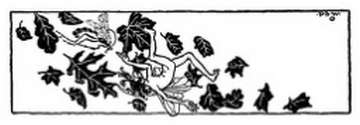
The Snow Queen
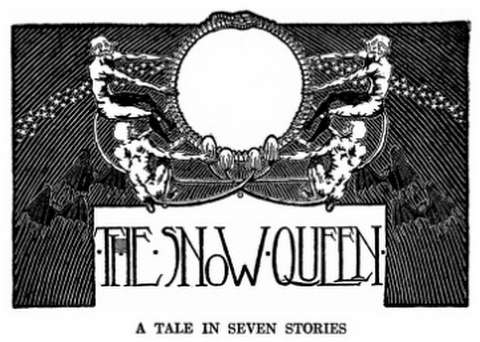
This is probably the best Andersen's fairy tale. While it starts with a wicked troll (a devil in disguise) and his magic mirror, which breaks, what leads to the kidnapping of a little boy by the Snow Queen, it's essentially a story of the fight between good and evil. This fight is presented through the journey of Gerda (kidnapped boy's best friend) who despite all the obstacles defeats the mighty queen and her magic.
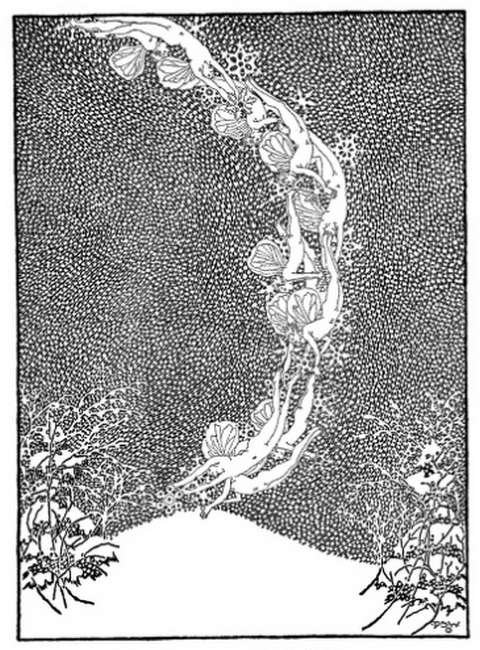
Look! The white bees are swarming
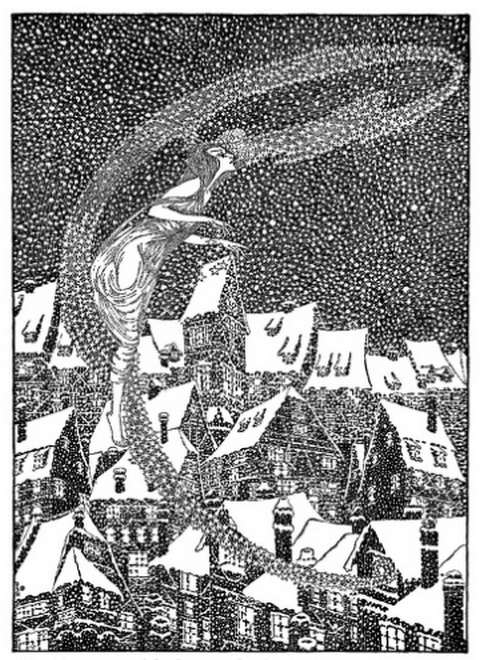
The biggest snowflake became the figure of a woman. She was delicately lovely, but all ice, glittering, dazzling ice
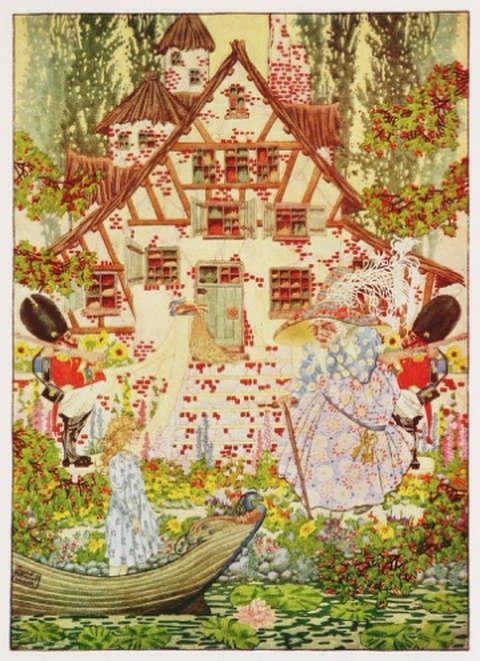
An old, old woman came out of the house ... she wore a big sun hat which was covered with beautiful painted flowers
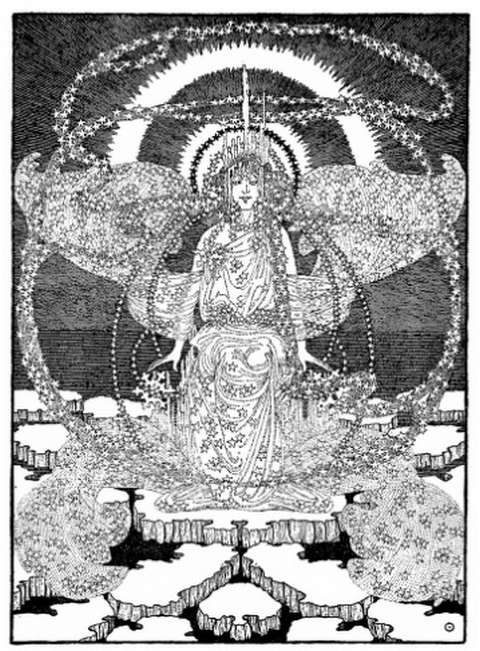
She than said that she was sitting on The Mirror of Reason, and that it was the best and only one in the world

What the Moon Saw

Originally published as The Picture Book without Pictures is a very unusual fairy tale, made of 33 unrelated scenes, impressions from the different locations with only one common feature - being observed by the moon. The scenes are different, mostly, yet not always dark and pessimistic. Considering the fact everything happens in the night the tone of the telling is understandable.
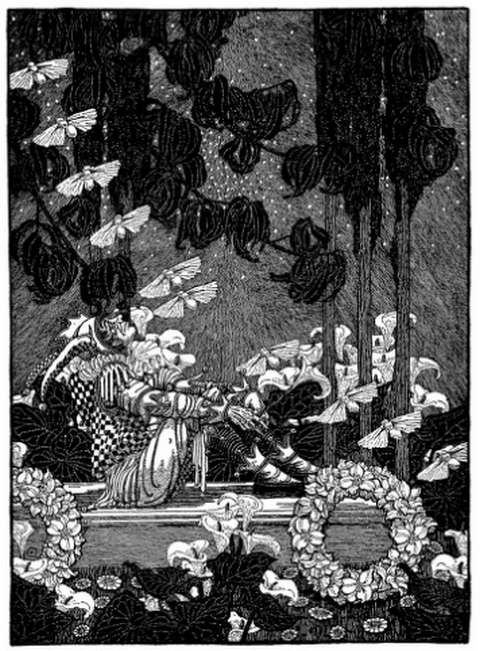
If the public had seen their favorite how they would have shouted Bravo! Bravissimo! Punchinello

Her thaughts wandered from her home and sought Temple, but not for the sake of God! Poor Pe! Poor Soui-houng!

The Marsh King's Daughter

This is the second longest fairy tale by H. C. Andersen. It tells a story about an evil Marsh King who kidnapped a fairy princess from Egypt. They had a daughter who came from the depths of the marsh as a flower and is adopted by Vikings. She becomes a beautiful yet bad-tempered girl by day and good-hearted giant toad by night. As a toad gets a chance to rescue a priest from the captivity. He tries to save her from the spell but is soon killed by robbers. Despite that, he helps her in the form of a ghost and she is finally saved by the sign of a cross. She finds her mother and together they return to Egypt. There she marries a prince but is visited by the priest who takes her to heaven for three minutes only. Unfortunately, three minutes in heaven means a hundred years on Earth what means everybody she knew already died. Then she died as well.
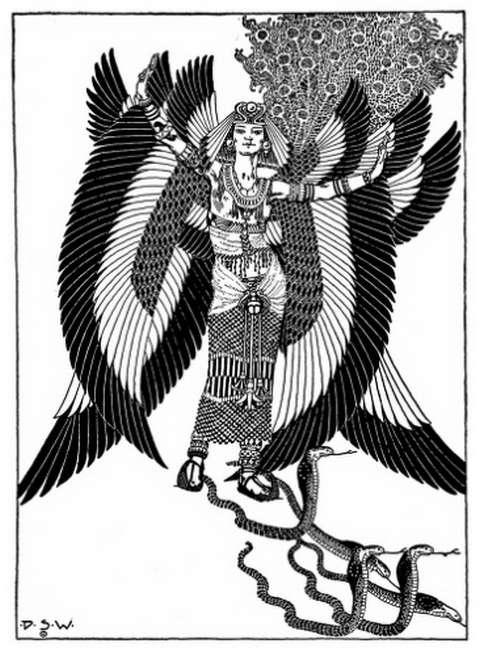
She who is related to the fairies!

You shouldn't even tell me anything of the sort just now, it might have a bad effect upon the eggs

The great dragon, hoarding his tresures, raised his head to look at them
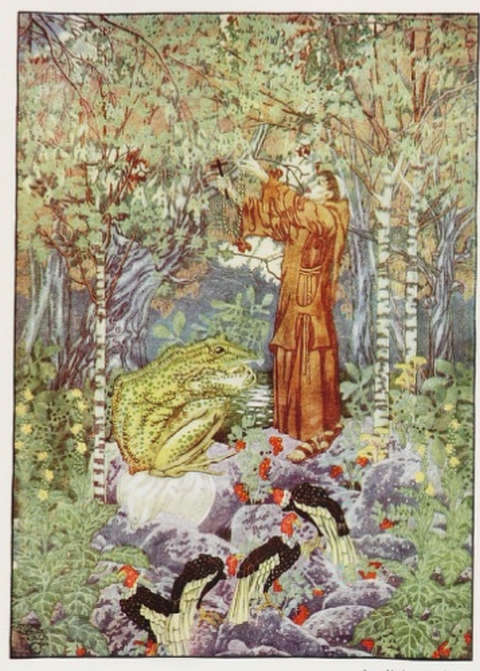
The Day-spring from on high hath visited us. To give light to them that sit in darkness, and to guide their feet into the way of peace
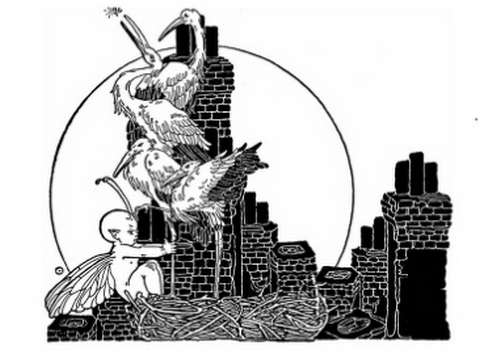
The Travelling Companions

Sometimes translated as The Travelling Companion the story presents a good man who is doing as many good deeds as possible in hope at least some of other people will follow his example. Among other things, he pays a debt of a dead man. Not long after a mysterious stranger asks him if they can travel together and the main character accepts. together they got into a land where a wicked princess asks her guests three questions. If they fell, they must die. Together they discover she is not wicked but under a spell, save her from the spell, the main character marries her and his traveling companion reveals him as the man whose debt he paid.
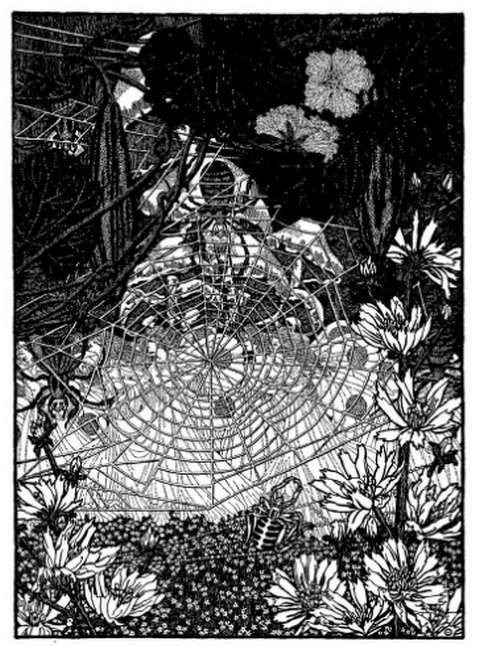
Great spiders spun their webs from branch to branch and the fairies swung hand in hand upon the big dewdrops which covered the leaves and the long grass

Oh what a flight that was through the air; the wind caught her cloak, and the moon shone through it
This concludes our journey in somehow dark yet beautiful fairy land of Hans Christian Andersen illustrated by Dugald Stewart Walker.